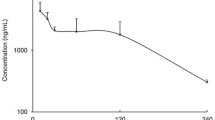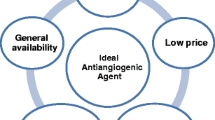Abstract
A study designed to compare the effects on VEGF-induced angiogenesis of a number of known anti-angiogenic agents together with some novel derivatives thereof was undertaken. Thus the isoflavone biochanin A 1, indomethacin 2, the 3-arylquinoxaline SU1433 and its derivatives 3–6, the benzoic acid derivative 7, the oxindoles SU5416 8 and SU6668 11, together with their simple N-benzyl derivatives 9, 10, and 12 were selected for study. Using an in vitro assay the compounds were evaluated for their ability to inhibit VEGF-induced angiogenesis in HUVECs, and the cytotoxicity of representative compounds was also studied in tumour cell lines using 24-h exposure. The results indicate that the SU compounds, SU1433, SU5416 and SU6668, are more potent inhibitors of VEGF-induced angiogenesis than indomethacin or the naturally occurring biochanin A, presumably because they inhibit VEGF receptor signalling. Blocking one of the phenolic OH groups of SU1433 reduced anti-angiogenic activity, as did blocking the NH groups of SU5416 and SU6668. Cytotoxicity studies indicate that none of the compounds examined exhibited cytotoxicity at anti-angiogenic concentrations.
Similar content being viewed by others
References
Folkman J. Tumor angiogenesis: Therapeutic implications. N Engl J Med 1971; 285: 1182–86.
Folkman J. Anti-angiogenesis: New concept for therapy of solid tumours. Ann Surg 1972; 175: 409–16.
Klohs WD, Hamby JM. Antiangiogenic agents. Curr Opin Biotechnol 1999; 10: 544–9.
Han ZC, Liu Y. Angiogenesis: State of the art. Int J Hematol 1999; 70: 68–82.
Kerbel RS. Tumor angiogenesis: Past, present and the near future. Carcinogenesis 2000; 21: 505–15.
Deplanque G, Harris AL. Anti-angiogenic agents: Clinical trial design and therapies in development. Eur J Cancer 2000; 36: 1713–24.
Eatock MM, Schatzlein A, Kaye SB. Tumour vasculature as a target for anticancer therapy. Cancer Treat Rev 2000; 26: 191–204.
Claffey KP, Robinson GS. Regulation of VEGF/VPF expression in tumor-cells-consequences for tumor-growth and metastasis. Cancer Metastasis Rev 1996; 15: 165–76.
Ferrara N, DavisSmyth T. The biology of vascular endothelial growth factor. Endocr Rev 1997; 18: 4–25.
Neufeld G, Cohen T, Gengrinovitch S, Poltorak Z. Vascular endothelial growth factor (vegf) and its receptors. Faseb J 1999; 13: 9–22.
Shweiki D, Itin A, Soffer D, Keshet E. Vascular endothelial growth-factor induced by hypoxia may mediate hypoxia-initiated angiogenesis. Nature 1992; 359: 843–5.
Kim KJ, Li B, Winer J et al. Inhibition of vascular endothelial growth factor-induced angiogenesis suppresses tumor-growth in vivo. Nature 1993; 362: 841–4.
Angelov L, Salhia B, Roncari L et al. Inhibition of angiogenesis by blocking activation of the vascular endothelial growth factor receptor 2 leads to decreased growth of neurogenic sarcomas. Cancer Res 1999; 59: 5536–41.
Rowe DH, Huang JZ, Kayton ML et al. Anti-VEGF antibody suppresses primary tumor growth and metastasis in an experimental model of Wilms' tumor. J Pediatr Surg 2000; 35: 30–2.
Chaplin DJ, Pettit GR, Hill SA. Anti-vascular approaches to solid tumour therapy: Evaluation of combretastatin a4 phosphate. Anticancer Res 1999; 19: 189–95.
Boehm T, Folkman J, Browder T, O'Reilly MS. Antiangiogenic therapy of experimental cancer doesnot induce acquired drug resistance. Nature 1997; 390: 404–7.
Workman P, Brunton VG, Robins DJ. Tyrosine kinase inhibitors. Cancer Biol 1992; 3: 369–81.
Bridges AJ. The epidermal growth factor receptor family of tyrosine kinases and cancer: Can an atypical exemplar be a sound therapeutic target? Curr Med Chem 1996; 3: 167–94.
Kolibaba KS, Druker BJ. Protein tyrosine kinases and cancer. Biochim BiophysActa Rev Can 1997; 1333: F217–48.
Schmittberger T, Waldmann H. Organic synthesis and biological signal transduction. Synlett 1998; 574–84.
He H, Venema VJ, Guo XL et al. Vascular endothelial growth factor signals endothelial cell production of nitric oxide and prostacyclin through flk-1/kdr activation of c-src. J Biol Chem 1999; 274: 25,130–5.
Kroll J, Waltenberger J. A novel function of VEGF receptor-2 (kdr): Rapid release of nitric oxide in response to VEGF-a stimulation in endothelial cells. Biochem Biophys Res Comm 1999; 265: 636–9.
Moody CJ, Rahimtoola KF, Porter B, Ross BC. Synthesis of the staurosporine aglycone. J Org Chem 1992; 57: 2105–14.
Strawn LM, McMahon G, App H et al. Flk-1 as a target for tumor growth inhibition. Cancer Res 1996; 56: 3540–5.
Nussbaumer P, Winiski AP, Cammisuli S et al. Novel antiproliferative agents derived from lavendustin-a. J Med Chem 1994; 37: 4079–84.
Sun L, Tran N, Tang F et al. Synthesis and biological evaluations of 3–substituted indolin-2–ones: A novel class of tyrosine kinase inhibitorsthat exhibit selectivity toward particular receptor tyrosine kinases. J Med Chem 1998; 41: 2588–603.
Sun L, Tran N, Liang CX et al. Design, synthesis, and evaluations of substituted 3–[(3–or 4–carboxyethylpyrrol-2–yl)methylidenyl]indolin-2–onesasinhibitorsof VEGF, FGF, and PDGF receptor tyrosine kinases. J Med Chem 1999; 42: 5120–30.
Jaffe EA, Nachman RL, Becker CG, Minick CR. Culture of human endothelial cellsderived from umbilical veins. Identification by morphologic and immunologic criteria. J Clin Invest 1973; 52: 2745–56.
Koolwijk P, vanErck MGM, deVree WJA et al. Cooperative effect of TNFa, bFGF, and VEGF on the formation of tubular structures of human microvascular endothelial cells in a fibrin matrix. Role of urokinase activity. J Cell Biol 1996; 132: 1177–88.
Mosmann T. Rapid colorimetric assay for cellular growth and survival: Application to proliferation and cytotoxicity assays. J Immunol Meth 1983; 65: 55–63.
Showalter HDH, Kraker AJ. Small molecule inhibitorsof the platelet-derived growth factor receptor, the fibroblast growth factor receptor, and src family tyrosine kinases. Pharmacol Therap 1997; 76: 55–71.
Fung MC, Szeto YY, Leung KN et al. Effects of biochanin a on the growth and differentiation of myeloid leukemia wehi-3b (jcs) cells. Life Sci 1997; 61: 105–15.
Verma SP, Goldin BR. Effect of soy-derived isoflavonoids on the induced growth of mcf-7 cells by estrogenic environmental chemicals. Nutr Cancer An Int J 1998; 30: 232–9.
Leahy KM, Koki AT, Masferrer JL. Role of cyclooxygenases in angiogenesis. Curr Med Chem 2000; 7: 1163–70.
Majima M, Hayashi I, Muramatsu M et al. Cyclo-oxygenase-2 enhances basic fibroblast growth factor-induced angiogenesis through induction of vascular endothelial growth factor in rat sponge implants. Br J Pharmacol 2000; 130: 641–9.
Masferrer JL, Koki A, Seibert K. Cox-2 inhibitors-a new class of antiangiogenic agents. Cancer prevention: Novel nutrient and pharmaceutical developments. Ann NY Acad Sci 1999; 889: 84–6.
O'Byrne KJ, Dalgleish AG, Browning MJ et al. The relationship between angiogenesis and the immune response in carcinogenesis and the progression of malignant disease. Eur J Cancer 2000; 36: 151–69.
Hu DE, Fan TPD. Suppression of vegf-induced angiogenesis by the protein-tyrosine kinase inhibitor, lavendustin-a. Br J Pharmacol 1995; 114: 262–8.
Fong TAT, Shawver LK, Sun L et al. SU5416 is a potent and selective inhibitor of the vascular endothelial growth factor receptor (flk-1/kdr) that inhibits tyrosine kinase catalysis, tumor vascularization, and growth of multiple tumor types. Cancer Res 1999; 59: 99–106.
Mendel DB, Laird AD, Smolich BD et al. Development of SU5416, a selective small molecule inhibitor of vegf receptor tyrosine kinase activity, as an anti-angiogenesis agent. Anticancer Drug Des 2000; 15: 29–41.
Shaheen RM, Davis DW, Liu WB et al. Antiangiogenic therapy targeting the tyrosine kinase receptor for vascular endothelial growth factor receptor inhibits the growth of colon cancer liver metastasis and induces tumor and endothelial cell apoptosis. Cancer Res 1999; 59: 5412–6.
Laird AD, Vajkoczy P, Shawver LK et al. SU6668 is a potent antiangiogenic and antitumor agent that induces regression of established tumors. Cancer Res 2000; 60: 4152–60.
Author information
Authors and Affiliations
Corresponding author
Rights and permissions
About this article
Cite this article
Whatmore, J.L., Swann, E., Barraja, P. et al. Comparative study of isoflavone, quinoxaline and oxindole families of anti-angiogenic agents. Angiogenesis 5, 45–51 (2002). https://doi.org/10.1023/A:1021528628524
Issue Date:
DOI: https://doi.org/10.1023/A:1021528628524




